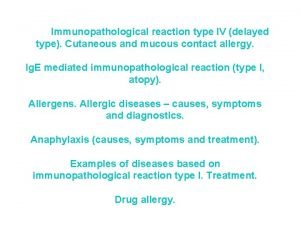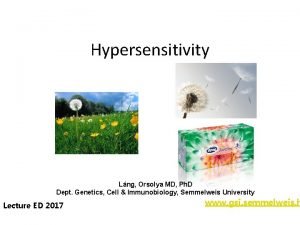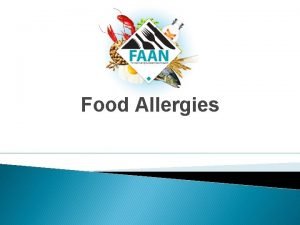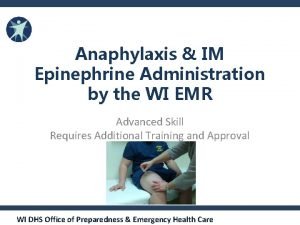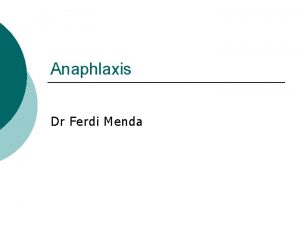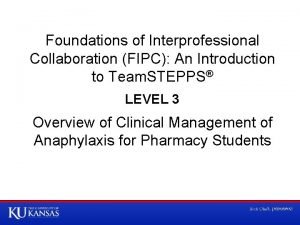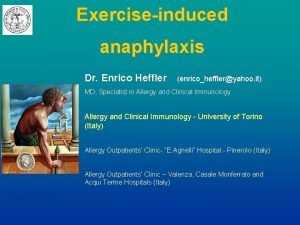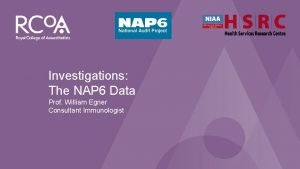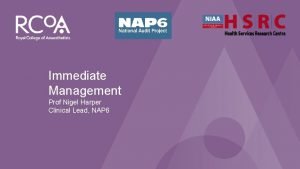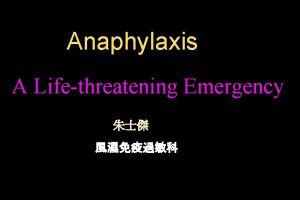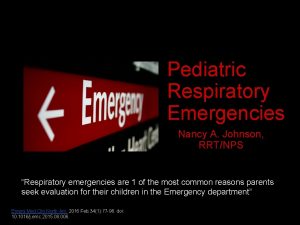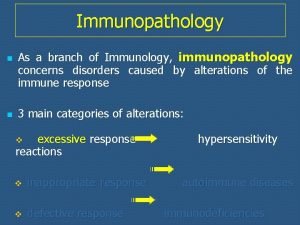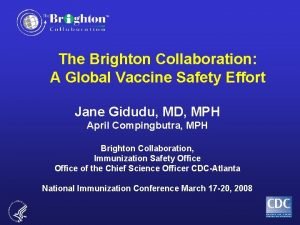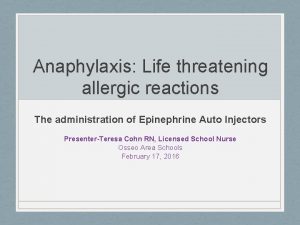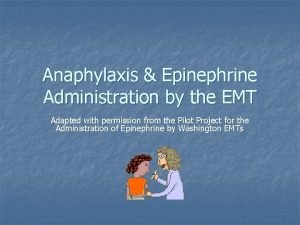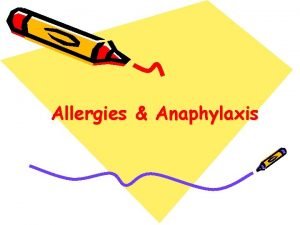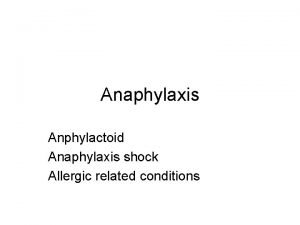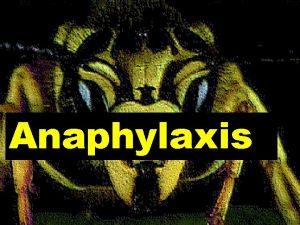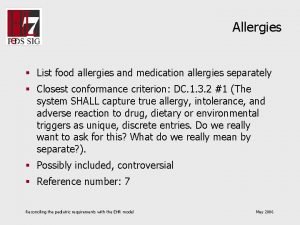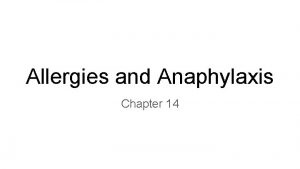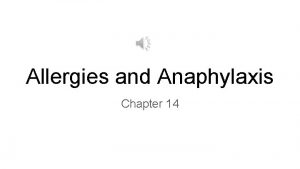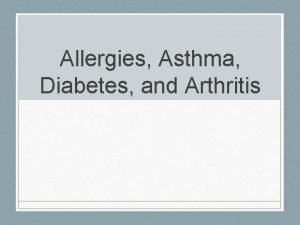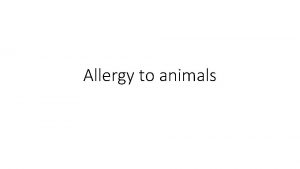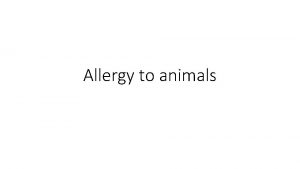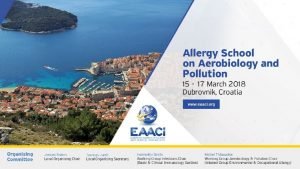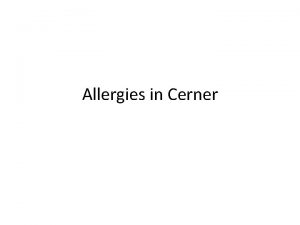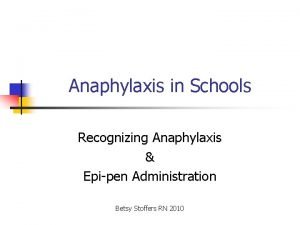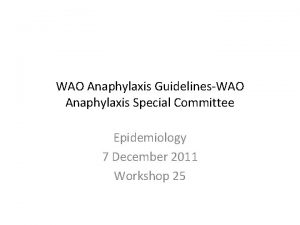World Allergy Week 2014 ANAPHYLAXIS When allergies can



















- Slides: 19

World Allergy Week 2014 ANAPHYLAXIS When allergies can be severe and fatal Are you ready for anaphylaxis?

Welcome to World Allergy Week 2014 Lanny Rosenwasser, MD President, World Allergy Organization The World Allergy Organization welcomes all of you to join us and all of the educators, healthcare practitioners, policymakers, parents, patients, advocates and medical professionals around the world to mark the fourth consecutive year of World Allergy Week by organizing and participating in activities that bring attention to the rising global prevalence of anaphylaxis. Motohiro Ebisawa, MD, Ph. D Chair, Communications Committee In keeping with the World Allergy Week tradition of bringing attention to a specific allergic disease each year, the World Allergy Organization has selected Anaphylaxis – When Allergies Can Be Severe and Fatal, Fatal emphasizing the great need for increased awareness, training, and resources that lead to improved safety and quality of life.

World Allergy Week 2014 Chairpersons Motohiro Ebisawa, MD and Paul Greenberger, MD WAO Communications Committee 2014 -2015 Chair: Motohiro Ebisawa (Japan) Co-Chair: Paul Greenberger (United States) Mona Al Ahmad (Kuwait) Paolo Barrera Perigault (Panama) Suwat Benjaponpitak (Thailand) Ake Davidsson (Sweden) Mohammad Gharagozlou (Iran) Elham Hossny (Egypt) Carla Irani (Lebanon) Juan Carlos Ivancevich (Argentina) Amir Hamzah Latiff (Malaysia) Hae-Ran Lee (Korea) Dilsad Mungan (Turkey) Ruby Pawankar (Japan) Harald Renz (Germany) Noel Rodriguez (Mexico) Menachem Rottem (Israel) Glenis Scadding (United Kingdom) Revaz Sepiashvili (Georgia) Elopy Sibanda (Zimbabwe) Mimi Tang (Australia) Stephen Tilles (United States) Richard Weber (United States)

Anaphylaxis is a hypersensitivity reaction to foreign substances such as foods, medications, and insect bites or stings. Anaphylaxis is a serious, life-threatening generalized or systemic hypersensitivity reaction and a serious allergic reaction that is rapid in onset and can be fatal. Symptoms may be throat swelling, itchy rash, and low blood pressure. Are you prepared for anaphylaxis?

Anaphylaxis is a global health concern. Anaphylaxis is a global public health concern. The rate of anaphylaxis occurrence seems to be increasing with geographic variations. • Data on the prevalence of anaphylaxis in the general population is limited. • However, the recent survey in the United States indicates that the prevalence of anaphylaxis in the general population is at least 1. 6% and probably higher. 1 • In contrast, a European study indicated that an estimated 0. 3% (95% CI 0. 1 -0. 5) of the population experience anaphylaxis at some point of time in their lives. 2 The WAO Anaphylaxis Guidelines published by the World Allergy Organization in 2011 should be disseminated to physicians throughout the world to prevent tragedies by anaphylaxis death. 3 The WAO White Book on Allergy: Update 2013, which addresses this issue for the public, patients and policy makers, should also be disseminated worldwide as an important educational and advocacy document. 4 1. Wood RA, Camargo CA, Lieberman P, Sampson HA. Anaphylaxis in America: The prevalence and characteristics of anaphylaxis in the United States. Journal of Allergy and Clinical Immunology 2014; 133(2): 461 -467. Access 2. Panesar SS, Javad S, de Silva D, Nwaru BI, Lickstein L et al. The epidemiology of anaphylaxis in Europe: a systemic review Allergy 2013; 68(11): 1353 -1361. Access 3. Simons FER, Ardusso LRF, Bilo MB, El Gamal Y, Ledford D et al. World Allergy Organization Guidelines for the assessment and management of anaphylaxis World Allergy Organization Journal 2011; 4: 13 -37. Access 4. Pawankar R, Canonica GW, Holgate S, Lockey R, Blaiss M eds. WAO White Book on Allergy, Update 2013. World Allergy Organization, 2013. Access

Causes of anaphylaxis • The relative importance of specific anaphylaxis triggers in different age groups appears to be universal. • Foods are the most common trigger in children, teens and young adults. • Insect stings and medications are relatively common triggers in middle-aged and elderly adults. When anaphylaxis can become worse or fatal Potential associated factors that can cause more severe forms and fatal allergies include: • age • physiologic state (such as pregnancy) • concomitant diseases ―poorly controlled asthma ―cardiovascular disease • concurrent use of medications ―Beta-adrenergic blockers ―ACE inhibitors • amplifying co-factors ―Exercise ―non-steroidal antiinflammatory drugs ―Infections ―emotional stress ―peri-menstrual status

Anaphylaxis mechanisms and triggers Figure 2, From the “WAO Guidelines for the Assessment & Management of Anaphylaxis” Simons FER et al. World Allergy Organization Journal 2011; 4: 13– 37 http: //www. waojournal. org/content /4/2/13 Note: Use of this figure is restricted by copyright law. Warning: The WAO Guidelines are intended for physician use only. All others, please contact your physician regarding preparation, treatment, and prevention of anaphylaxis.

Patient factors that contribute to anaphylaxis Figure 1, From the “WAO Guidelines for the Assessment & Management of Anaphylaxis” Simons FER et al. World Allergy Organization Journal 2011; 4: 13– 37 http: //www. waojournal. org/con tent/4/2/13 Note: Use of this figure is restricted by copyright law. Warning: The WAO Guidelines are intended for physician use only. All others, please contact your physician regarding preparation, treatment, and prevention of anaphylaxis.

Symptoms and signs of anaphylaxis Skin, subcutaneous tissue, and mucosa Flushing, itching, urticaria (hives), angioedema, morbilliform rash, pilor erection Periorbital itching, erythema and edema, conjuncitval erythema, tearing Itching of lips, tongue, palate, and external auditory canals; and swelling of lips, tongue, and uvula Respiratory Nasal itching, congestion, rhinorrhea, sneezing Throat itching and tightness, dysphonia, hoarseness, stridor, dry staccato cough Lower airways: increased respiratory rate, shortness of breath, chest tightness, deep cough, wheezing/bronchospasm, decreased peak expiratory flow Cyanosis Respiratory arrest Gastrointestinal Abdominal pain, nausea, vomiting (stringy mucus), diarrhea, dysphagia Cardiovascular system Chest pain Tachycardia, bradycardia (less common), other arrhythmias, palpitations Hypotension, feeling faint, urinary or fecal incontinence, shock Cardiac arrest Central nervous system Aura of impending doom, uneasiness (in infants and children, sudden behavioral change, eg. irritability, cessation of play, clinging to parent); throbbing headache (pre-epinephrine), altered mental status, dizziness, confusion, tunnel vision Other Metallic taste in the mouth Cramps and bleeding due to uterine contractions in females Table 2, From the “WAO Guidelines for the Assessment & Management of Anaphylaxis” Simons FER et al. World Allergy Organization Journal 2011; 4: 13– 37 http: //www. waojournal. org/content/4/2/13 Note: Use of this table is restricted by copyright law. Warning: The WAO Guidelines are intended for physician use only. All others, please contact your physician regarding preparation, treatment, and prevention of anaphylaxis.

Clinical criteria for the diagnosis of anaphylaxis Figure 3, From the “WAO Guidelines for the Assessment & Management of Anaphylaxis” Simons FER et al. World Allergy Organization Journal 2011; 4: 13– 37 http: //www. waojournal. org/conten t/4/2/13 Note: Use of this figure is restricted by copyright law. Warning: The WAO Guidelines are intended for physician use only. All others, please contact your physician regarding preparation, treatment, and prevention of anaphylaxis. Posters and laminated pocket cards available from WAO. Access the order form at: http: //www. worldallergy. org/User. Files/file /Pocket. Card. Poster. Order. Form. pdf

Preparing for anaphylaxis involves having a written emergency protocol and rehearsing it regularly. Protocol: 1. 2. 3. 4. Place the patient on the back (or in a position of comfort if there is respiratory distress and/or vomiting. Elevate the lower extremities. Administer adrenaline* Assess circulation, airway, breathing, and mental status, skin, and other visual indicators. Adrenaline Intramuscularly administered-adrenaline (epinephrine) is life-saving for the treatment of anaphylaxis. • It relieves the symptoms of anaphylaxis including preventing, and relieving, airway obstruction via Beta-2 adrenergic effects caused by mucosal edema and smooth muscle concentration. • It prevents and relieves fall in blood pressure and shock. Prevention: It is important to advise patients about the need to have as-advised regular follow-up visits with a physician, preferably an allergy/immunology specialist, to: • confirm their specific trigger(s) of anaphylaxis) • prevent recurrences by avoiding the specific trigger(s) • have an emergency action plan and emergency medication on hand • have support from the family members • receive immunomodulation, where it is clinically approved and relevant Immunomodulation is Immunotherapy with Hymenoptera venoms or fire ant extracts which are effective therapies to reduce the risk of anaphylaxis.

Basic management of anaphylaxis Figure 4, From the “WAO Guidelines for the Assessment & Management of Anaphylaxis” Simons FER et al. World Allergy Organization Journal 2011; 4: 13– 37 http: //www. waojournal. org/content/ 4/2/13 Note: Use of this figure is restricted by copyright law. Warning: The WAO Guidelines are intended for physician use only. All others, please contact your physician regarding preparation, treatment, and prevention of anaphylaxis. Posters and laminated pocket cards available from WAO. Access the order form at: http: //www. worldallergy. org/User. Files/file /Pocket. Card. Poster. Order. Form. pdf

Discharge management and prevention of future anaphylaxis recurrences in the community Figure 5, From the “WAO Guidelines for the Assessment & Management of Anaphylaxis” Simons FER et al. World Allergy Organization Journal 2011; 4: 13– 37 http: //www. waojournal. org/content /4/2/13 Note: Use of this figure is restricted by copyright law. Warning: The WAO Guidelines are intended for physician use only. All others, please contact your physician regarding preparation, treatment, and prevention of anaphylaxis.

The WAO White Book on Allergy Update 2013 Section 2. 5. Anaphylaxis- Key Statements Richard F. Lockey, Stephen F. Kemp, Philip L. Lieberman, Aziz Sheikh • Epinephrine (adrenaline) at appropriate doses, injected intramuscularly into the midanterior lateral thigh, is the drug of choice to treat anaphylaxis. • Anaphylaxis includes both allergic and non-allergic etiologies. • The term “anaphylactoid” is outdated. • The variability and severity of anaphylaxis is somewhat dependent on the route by which the allergen or inciting agent is delivered, e. g. , parenteral versus oral administration; the former is commonly associated with more severe reactions. WAO White Book on Allergy Update 2013 Editors: R Pawankar, GW Canonica, S Holgate, R Lockey, M Blaiss http: //www. worldallergy. org/definingt hespecialty/white_book. php

To learn more about anaphylaxis World Allergy Organization Resources http: //www. worldallergy. org/anaphylaxis www. worldallergyweek. org Patient Advocacy: Allergy and Anaphylaxis Australia Fact Sheets, Allergen Specifics http: //www. allergyfacts. org. au/living-with-therisk/allergen-specifics School Resources http: //www. allergyfacts. org. au/caring-forthose-at-risk/school-resources Anaphylaxis Campaign Fact Sheets http: //www. anaphylaxis. org. uk/what-isanaphylaxis/our-factsheets Anaphylaxis Canada Helpful Info http: //www. anaphylaxis. ca/en/resources/helpful _info. html Anaphylaxis Ireland Informational leaflets http: //www. anaphylaxisireland. ie/? page_id=124 Food Allergy Research & Education (FARE) Resources http: //www. foodallergy. org/resources-for

About the World Allergy Organization The World Allergy Organization is an international alliance of 95 regional and national allergy, asthma and immunology societies. Through collaboration with its Member Societies WAO provides a wide range of educational and outreach programs, symposia and lectureships to allergists/immunologists around the world and conducts initiatives related to clinical practice, service provision, and physical training in order to better understand address the challenges facing allergists/immunologists worldwide. www. worldallergy. org

Member Societies of the World Allergy Organization ASIA AND PACIFIC Allergy & Immunology Society of Sri Lanka Allergy and Clinical Immunology Society (Singapore) Allergy and Immunology Society of Thailand Asia Pacific Association of Allergy, Asthma, and Clinical Immunology Asia Pacific Association of Pediatric Allergy, Respirology and Immunology Australasian Society of Clinical Immunology and Allergy Azerbaijan Society for Asthma, Allergy and Clinical Immunology Bangladesh Society of Allergy and Immunology Chinese Society of Allergology Hong Kong Institute of Allergy Indian Academy of Allergy Indian College of Allergy, Asthma and Clinical Immunology Indonesian Society of Allergy and Immunology Japanese Society of Allergology Korean Academy of Asthma, Allergy and Clinical Immunology Malaysian Society of Allergy and Immunology Mongolian Society of Allergology Taiwan Academy of Pediatric Allergy Asthma Immunology Vietnam Association of Allergy, Asthma and Clinical Immunology LATIN AMERICA Argentine Association of Allergy and Immunology Argentine Society of Allergy and Immunology Brazilian Society of Allergy and Immunology Chilean Society of Allergy and Immunology Colombian Allergy, Asthma and Immunology Association Cuban Society of Allergology Ecuadorian Society of Allergy, Asthma, and Immunology Guatemalan Allergy, Asthma, and Clinical Immunology Society Honduran Society of Allergy and Clincial Immunology AFRICA AND MIDDLE EAST Allergy Society of Kenya Allergy Society of South Africa Egyptian Society of Allergy and Clinical Immunology Egyptian Society of Pediatric Allergy and Immunology Iranian Society of Asthma and Allergy Israel Association of Allergy and Clinical Immunology Jordanian Society for Allergy and Clinical Immunology Kuwait Society of Allergy & Clinical Immunology Lebanese Society of Allergy and Immunology Moroccan Society of Allergology and Clinical Immunology National Association for Private Algerian Allergists Serbian Association of Allergologists and Clinical Immunologists Tunisian Society of Respiratory Diseases and Allergology Turkish National Society of Allergy and Clinical Immunology Zimbabwe Allergy Society Latin American Society of Allergy and Immunology Mexican College of Allergy and Clinical Immunology (CMICA) Mexican College of Pediatricians Specialized in Allergy and Clinical Immunology Panamanian Association of Allergology and Clinical Immunology Paraguayan Society of Allergy, Asthma, and Immunology Peruvian Society of Allergy and Immunology Philippine Society of Allergy, Asthma and Immunology Uruguayan Society of Allergology Venezuelan Society of Allergy, Asthma and Immunology –continued

Member Societies of the World Allergy Organization EUROPE Albanian Society of Allergology and Clinical Immunology Armenian Association of Immunology and Allergy Austrian Society of Allergology and Immunology Belarus Association of Allergology & Clinical Immunology Belgian Society of Allergy and Clinical Immunology British Society of Allergy and Clinical Immunology Bulgarian National Society of Allergology Commonwealth of Independent States Society of Allergology and Immunology Croatian Society of Allergology and Clinical Immunology Czech Society of Allergology and Clinical Immunology Danish Society for Allergology Dutch Society of Allergology European Academy of Allergy and Clinical Immunology (EAACI) Finnish Society of Allergology and Clinical Immunology French Society of Allergology and Clinical Immunology Georgian Association of Allergology and Clinical Immunology German Society for Allergology and Clinical Immunology Hellenic Society of Allergology and Clinical Immunology AFFILIATE ORGANIZATIONS British Society for Immunology Global Allergy and Asthma European Network (GA 2 LEN) International Association of Asthmology (INTERASMA) International Primary Care Respiratory Group (IPCRG) Southern European Allergy Societies (SEAS) Hungarian Society of Allergology and Clinical Immunology Icelandic Society of Allergy and Clinical Immunology Italian Association of Territorial and Hospital Allergists Italian Society of Allergology and Clinical Immunology Latvian Association of Allergists Moldavian Society of Allergology & Immunology Norwegian Society of Allergology and Immunopathology Polish Society of Allergology Portuguese Society of Allergology and Clinical Immunology Romanian Society of Allergology and Clinical Immunology Russian Association of Allergology and Clinical Immunology Slovenian Association for Allergology & Clinical Immunology Spanish Society of Allergology and Clinical Immunology Swedish Association for Allergology Swiss Society of Allergology and Immunology Ukrainian Allergists Association Ukrainian Association of Allergologists and Clinical Immunologists NORTH AMERICA American Academy of Allergy, Asthma and Immunology American College of Allergy, Asthma and Immunology Canadian Society of Allergy and Clinical Immunology

How are you raising awareness of anaphylaxis? Tell us about your activities for World Allergy Week 2014. Email: info@worldallergy. org Facebook: facebook. com/worldallergy. org Twitter: @worldallergy #World. Allergy. Week www. worldallergyweek. org “This program is supported by an independent educational grant from Mylan Specialty and Kaleo”
 World allergy organ j
World allergy organ j Anaphylactoid vs anaphylaxis
Anaphylactoid vs anaphylaxis Anaphylaxis grade
Anaphylaxis grade Arthus reaction
Arthus reaction Anaphylaxis onset
Anaphylaxis onset Lateral thigh injection site
Lateral thigh injection site Anaphlaxis
Anaphlaxis Anaphylaxis classification
Anaphylaxis classification Interprofessional care for anaphylaxis
Interprofessional care for anaphylaxis Anaphylaxis
Anaphylaxis Nap anaphylaxis
Nap anaphylaxis Nap 6 recommendations
Nap 6 recommendations Anaphylaxis treatment
Anaphylaxis treatment Anaphylaxis
Anaphylaxis Hypersensitivity types examples
Hypersensitivity types examples Brighton collaboration case definitions for vaccines
Brighton collaboration case definitions for vaccines Sjs
Sjs Anaphylaxis photos
Anaphylaxis photos Anaphylaxis ig
Anaphylaxis ig Epinephrine dosage emt
Epinephrine dosage emt


